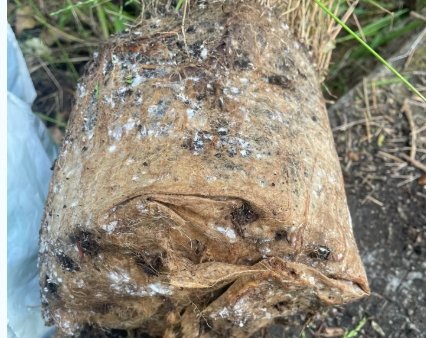Mealy bugs, trimming, and a list of tasks as long as yer arm
We’ve had some beaut weather and some awful weather eh! Ah well, onwards and upwards. Sometimes you have to remove trees you don’t want to remove, but we have four huge native fuschia trees on one property and one had to go before it damaged the house. The flowers are stunners-
All the same it wasn’t great to have to remove it.
What I'm obsessing over this week
Soil mealybug. I see it most often in pots of plants recently purchased, which is sad because it means a nursery has an infection they aren’t able to manage.
Soil mealybug are often to blame for random deaths, or struggling plants- they slowly take all of the energy out of the plant and damage the root tips which are responsible for nutrient uptake. It is pretty easy to identify- white fluff which looks a lot like mould on and around the plant roots.
Here is a pretty nasty case of a plant which should have been planted a long time ago, and is also heavily infested with soil mealy.
What can you do about soil mealy? Some people advocate for making a drench of 3% hydrogen peroxide and water (1:3), this is really expensive because you need enough liquid to completely fill the entire root section. This is easy with pots but hard with plants in the ground, which will need about a bucketful, and some careful watering of the solution to get it everywhere. Similarly apparently you can do it with neem, or soap. All of these options limit healthy bug and fungal growth to some extent which is a pity.
I am now removing plants which have soil mealy and doing a full hydrogen peroxide drench in the hole, not planting there for a while after (this season? Does it matter- because the mealy will just spread to neighbouring plants?). I am going to sit on this issue for a bit to be honest, aside from careful purchasing and stopping them from reaching the garden… I have no good winning options right now.
What staff learnt about this week
Our weekly focus was hedge trimming. The best way to trim something well is to take your time and go over it multiple times. The second best is regular trimming- four weekly or so, and keeping up with feeding.
We spoke a lot about clipping the corners first to set the height and size, and then trimming the hedge to match the corners. We also spoke about locking your body into position and then walking instead of moving your arms and shoulders, a technique which is hell on the muscles but great for consistency of height.
Highlights: By the end of the week, we were sharing our wins- lots of balls, cones, tightly packed buxus.
Lowlights: Poor Catherine was off this week until Friday, so while we were talking about the finer points, she had missed the basics. We are going to go over it again next week.
Some garden tasks for this week
We are
Trimming all of the hedges, and spraying them once trimmed with seaweed feed (and if buxus, or a plant prone to thrip, we also include horticultural soap to keep the fungal infections away).
Trimming magnolias and michelias- yes, now is the time- because they have recently stopped flowering. People are inclined to wait until Autumn to trim them- but if you do that, you are taking off flower buds.
So much weeding. If you have too much weeding to do, start by removing all weeds which are going to seed (flowering), because you are at least stopping them from spreading.
Convolvulous is back, so carefully weeding it and taking as much of the root out as possible.
Because of the heat, this is also a good time to take a weedeater to any big build up of tradescantia on a really sunny day. The chopped off tops will die off (unlike in Winter, where you are just spreading it).
I have also planted more tomatoes, beans, lettuce and basil, and encourage you to do the same!
If your plants have yellowing leaves, giving them a liquid feed is a good idea to boost their food. We are also giving them a little molasses (2 tablespoons to 2L water).
Have a great week everyone!

